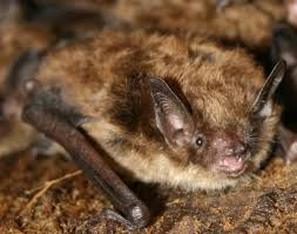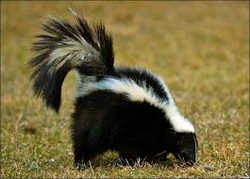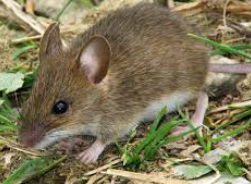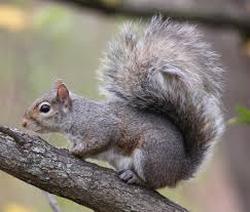Bats (Big Brown Bats or Little Brown Bats)
 Little brown bats migrate every year and hibernate in caves and mines. Big brown bats remain in New England and hibernate in your house, often your attic. They are nocturnal and feed on mosquitoes and other insects. They can eat up to 50% of their body weight in one feeding.
Little brown bats migrate every year and hibernate in caves and mines. Big brown bats remain in New England and hibernate in your house, often your attic. They are nocturnal and feed on mosquitoes and other insects. They can eat up to 50% of their body weight in one feeding.- Bats have their pups from May to August and usually have only one pup per litter. Pups usually begin to fly in July.
- Bat feces (guano) can cause damage and staining to your home, it can also contain diseases such as histoplasmosis which is a disease that can be transmitted from animals to humans. Bats are one of the primary carriers of the rabies, which is highly contagious and deadly.
Methods of Removal:Prevention and Exclusion
Gray Squirrels
- Gray squirrels nest in trees and often your home. They eat a variety of foods, mostly nuts and berries. Squirrels can breed twice a year. The first litter is usually born in February or March, and the second in June or July. Typical litter size is 1-4, however they can have up to 8 in one litter.
- Gray Squirrels can cause extensive damage by gnawing on your home both inside and outside. They can also rip up insulation to use as nesting material. They can carry leptospirosis and salmonella in their urine and feces, which are harmful to people as well as pets in the home.
Methods of Removal:Prevention, Exclusion, and Trapping
Skunks
 Skunks are burrowing animals that will often take up residence under decks and sheds. They are omnivorous and eat a variety of different foods.
Skunks are burrowing animals that will often take up residence under decks and sheds. They are omnivorous and eat a variety of different foods.- Kits are often born in May in litters of 4-7. Their best defense is their ability to spray their scent glands to ward off predators.
- Skunks are carriers of leptospirosis, listeriosis, and rabies which are harmful humans and pets and can be deadly.
Methods of Removal: Prevention, Exclusion, and Trapping
Mice
 Mice are found in many different environments and settings. They are small creatures that can fit through holes as small as 1/4 of an inch. They are mostly herbivores, but are opportunistic feeders.
Mice are found in many different environments and settings. They are small creatures that can fit through holes as small as 1/4 of an inch. They are mostly herbivores, but are opportunistic feeders.- They breed year round, and can produce litters of 3-12 pups 5-10 times a year. That’s up to 120 pups in one year!
- They create nests in your home, and can chew on wiring and insulation. They carry fleas, which can infest your home. As well as the hantavirus, leptospirosis, and tulaermia, which are diseases that can be transmitted to humans and can be deadly.
Methods of Removal:Prevention, Exclusion, and Trapping
Woodchucks (also known as Groundhogs and Whistle Pigs)
 Woodchucks live in burrows, which can have up to 45 feet of tunnels and can be 5 feet under ground. They typically have 2 chambers: 1 where they sleep and breed and one where they defecate.
Woodchucks live in burrows, which can have up to 45 feet of tunnels and can be 5 feet under ground. They typically have 2 chambers: 1 where they sleep and breed and one where they defecate.- Young are born in May, usually 2-6 per litter.
- Their network of tunnels can collapse walkways and they love to eat the vegetables growing in your garden.
Methods of Removal: Prevention, Exclusion, and Trapping
Flying Squirrels

- Flying squirrels do not actually fly, they glide from tree to tree. They create nests in trees and attics. They are nocturnal and eat nuts, berries, insects, and carrion. They can fit through small holes the size of a quarter.
- They breed March-May and can have up to 6 per litter.
- Flying squirrels chew on wires, nest in insulation, and cause staining on soffits and eaves of homes from their urine and feces. They are known to carry typhus, which is a public health risk.
Methods of Removal: Prevention, Exclusion, and Trapping
Raccoons
- Raccoons live everywhere- from deep forests to urban environments. They are omnivores and their diets change depending on where they are living.
- They breed once a year April-May and can have up to 6 per litter.
- Raccoons will often nest in chimneys and attics causing odors in the home and destroying insulation. They can carry rabies, leptospirosis, salmonella, and roundworms which can be transmitted to humans and to pets living in your home.
Methods of Removal: Prevention, Exclusion, and Trapping


